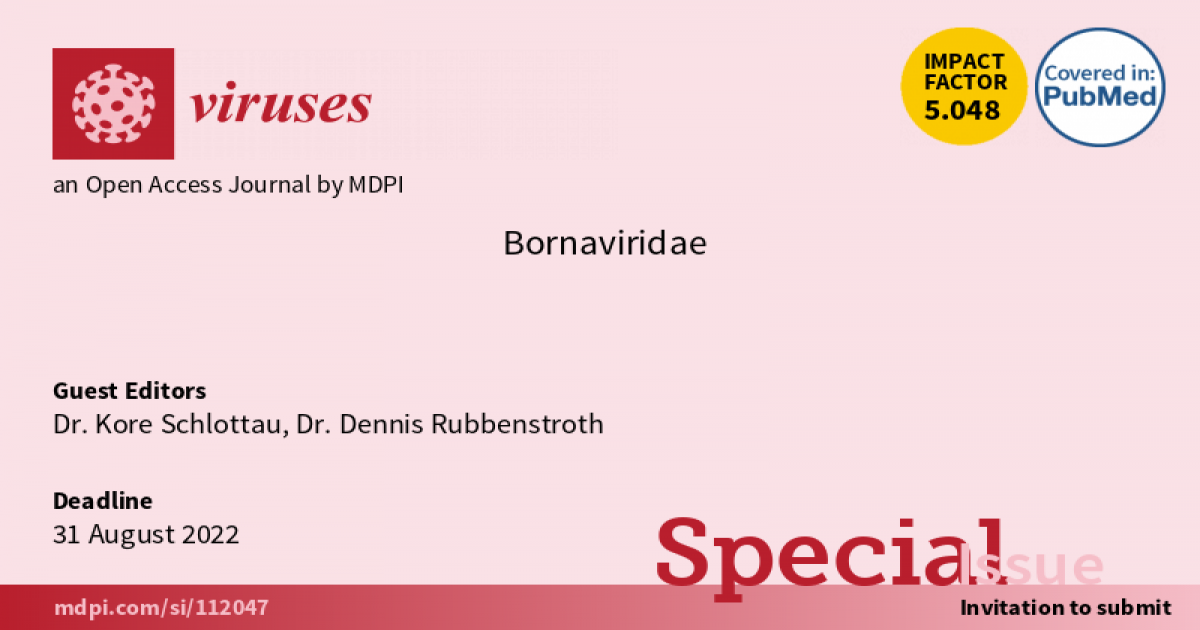Bornaviridae
A special issue of Viruses (ISSN 1999-4915). This special issue belongs to the section "Animal Viruses".
Deadline for manuscript submissions: closed (30 November 2022) | Viewed by 27276

Special Issue Editors
Interests: neurotropic viruses; bornaviruses; zoonoses; pathogenesis; neuroinvasion; molecular biology
Special Issue Information
Dear Colleagues,
The Bornaviridae family has attracted increased attention over the past few years. Its number of classified members is continuously rising, now including viruses of three genera that can infect mammals, birds, fish, and reptiles. Two of its members, Borna disease virus 1 (BoDV-1) and variegated squirrel bornavirus 1 (VSBV-1), were recently confirmed, beyond doubt, to cause fatal encephalitis in humans following zoonotic transmission from their natural reservoir hosts. Furthermore, some bornaviruses cause neurologic disorders of marked veterinary impact, such as Borna disease in domestic mammals or proventricular dilatation disease (PDD) in parrots. Although these viruses have been well studied in recent years, many questions around their biology still remain elusive, regarding, for example, their epidemiology, transmission, pathogenesis, persistence mechanisms, and the efficacy of antiviral therapeutics.
This Special Issue seeks all types of manuscripts that will highlight and advance our current understanding of this virus family, with particular focus on mammalian bornaviruses with zoonotic potential, but contributions on avian bornaviruses as well as newly discovered bornaviruses from other animals are also highly welcome.
Dr. Kore Schlottau
Dr. Dennis Rubbenstroth
Guest Editors
Manuscript Submission Information
Manuscripts should be submitted online at www.mdpi.com by registering and logging in to this website. Once you are registered, click here to go to the submission form. Manuscripts can be submitted until the deadline. All submissions that pass pre-check are peer-reviewed. Accepted papers will be published continuously in the journal (as soon as accepted) and will be listed together on the special issue website. Research articles, review articles as well as short communications are invited. For planned papers, a title and short abstract (about 100 words) can be sent to the Editorial Office for announcement on this website.
Submitted manuscripts should not have been published previously, nor be under consideration for publication elsewhere (except conference proceedings papers). All manuscripts are thoroughly refereed through a single-blind peer-review process. A guide for authors and other relevant information for submission of manuscripts is available on the Instructions for Authors page. Viruses is an international peer-reviewed open access monthly journal published by MDPI.
Please visit the Instructions for Authors page before submitting a manuscript. The Article Processing Charge (APC) for publication in this open access journal is 2600 CHF (Swiss Francs). Submitted papers should be well formatted and use good English. Authors may use MDPI's English editing service prior to publication or during author revisions.
Keywords
- borna disease virus
- variegated squirrel borna virus 1
- orthobornaviruses
- bornaviridae
- encephalitis
- pathogenesis
- phylogeny
- epidemiology
- diagnosis






